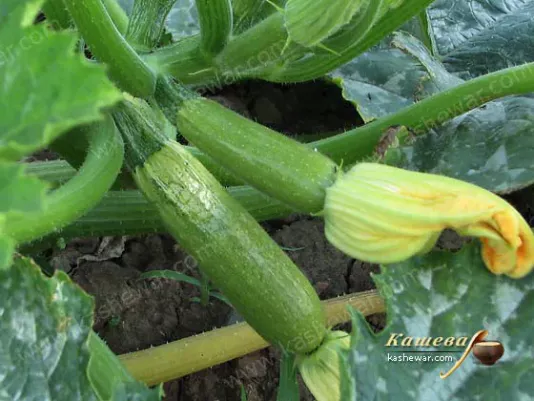Zucchini Fritters with Hot Pepper
Zucchini pancakes with hot peppers are a Chinese recipe that is very good for breakfast.

Light green zucchini are among the most versatile vegetables I use every year. Over time, I’ve learned that their flavor depends on ripeness: young ones are tender and slightly sweet, while older ones are better suited for casseroles or preservation. I always pay attention to the skin – it should be smooth and spotless. Light green zucchini should be stored in a cool, dry place where they won’t wilt. In my kitchen, I use them both as a main ingredient and as a complement, since they beautifully balance the flavor of a dish. The simplicity of this vegetable demands precision: a bit of salt, the right temperature, and attentiveness – that’s the secret to a perfect result, even in the humblest dish.
When choosing light green zucchini, I always check their surface – it should be smooth, without cracks or wrinkles. Young vegetables have thin skin that can be easily pressed with a fingernail, and pale flesh with small seeds. If the fruit is too firm or the skin is rough, it’s overripe, and such flesh will lose its tenderness when cooked. The best ones are medium-sized, around 20 centimeters long, as they have the most distinct flavor. Over the years, I’ve learned to recognize quality by touch: fresh light green zucchini feel firm but not hard. I store them in the fridge in a perforated bag to prevent moisture buildup. If I plan to cook them in a few days, I always dry them thoroughly after washing – excess water causes spoilage. Sometimes I freeze sliced rounds – they’re great for soups and stews. I’ve found that freshness defines the flavor of the final dish, so I buy only as many light green zucchini as I can use within two or three days. That ensures true aroma and proper texture.
Before cooking, I always pay attention to each stage of preparation. For young light green zucchini, it’s enough to wash them well, trim the ends, and pat dry with a towel. Older ones I peel and remove the large seeds to avoid a coarse texture. When frying, I slice them evenly – this helps the flesh heat uniformly and prevents it from soaking up too much oil. For baking, I cut them thicker so the pieces stay juicy. I always salt light green zucchini 10-15 minutes before cooking: this draws out excess moisture, so the dish doesn’t become soggy. I drain the liquid and gently pat the slices dry with paper towels. It’s a small detail, but it makes all the difference in the final result. When stewing, I add salt and spices near the end so the vegetables don’t become watery. Over the years, I’ve learned to recognize the right doneness – the flesh should remain tender but not fall apart. Preparing light green zucchini doesn’t take effort, only attentiveness and understanding of their texture.
Light green zucchini are extremely sensitive to temperature. Over high heat, they quickly lose moisture, so I always cook them over medium or moderate heat. For pan-frying, it’s enough for the oil to sizzle gently – this allows the slices to brown evenly while staying tender inside. When baking, I set the oven to 190-200°C (375-390°F): that’s the ideal range to preserve their shape and create a soft crust. When making light green zucchini fritters, I never let the batter sit too long – salt draws out liquid, and the mix becomes runny. I’ve noticed that excessive heating makes them fibrous, so I remove them from the heat as soon as they change color and become pliable. For grilling, it’s important to brush the slices with oil beforehand to prevent sticking. Steaming also works well but should last only a few minutes. Light green zucchini don’t tolerate reheating – they lose both texture and aroma – so it’s best to cook only as much as you’ll eat in one meal.
Light green zucchini work well with both bold and delicate combinations. I often pair them with tomatoes, garlic, and fresh herbs – it’s a natural harmony. In warm dishes, they go perfectly with mild cheeses like feta or mozzarella. When I want a more pronounced taste, I add lemon juice or balsamic vinegar – it enhances the sweetness of the flesh. Light sauces work best: yogurt with herbs, creamy garlic, or olive dressing with lemon. In my experience, light green zucchini make an excellent base for pasta, as their softness balances strong sauces. In salads, I use raw ribbons of light green zucchini – they retain freshness and a pleasant crunch. To enrich the aroma, I sometimes add cumin, coriander, or ground paprika, but I never overload the dish with spices. The value of light green zucchini lies in the fact that they don’t overpower other flavors but unite them into a natural, gentle ensemble.
The most common mistake is excess moisture. Light green zucchini are nearly half water, so even slight overcooking turns them into a shapeless mass. I always follow the rule: less time, less liquid. The second mistake is using too much oil. Because of their porous texture, light green zucchini absorb it quickly, so the pan should only be lightly greased. It’s also important not to leave cut slices exposed for too long – they darken and lose firmness. To avoid that, I keep them in the fridge under a towel. Another issue is uneven slicing: slices that are too thin burn, while thick ones stay raw. Over the years, I’ve developed the habit of checking the texture by touch – if it’s firm but yielding, it’s done. When cooking for storage, I always let the vegetables cool before packing to prevent condensation. I believe success with light green zucchini isn’t in the recipe but in the attention to detail that defines the flavor and texture of the finished dish.